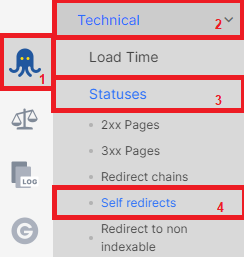
Self-redirecting URLs: what’s the reason?
During website analysis, you may encounter pages that have self-redirects. In this article, we will explain what self-redirects are, explore the possible reasons behind them, and provide guidance on how to address them effectively.
What are self-redirects?
Self-redirects refer to internal redirects that direct back to the same URL. For instance, a page like https://example.com/category/1 redirects to the identical URL: https://example.com/category/1. It’s important to note that self-redirects can take different types, such as permanent redirects (301, 308) or temporary redirects (302, 307).
Moreover, there might be additional URLs involved in the chain of self-redirects. For example, https://example.com/category/1 redirects to https://example.com/category/2, which then redirects back to https://example.com/category/1. Such redirect loops can pose technical issues for your website.
Why is it important to check self-redirecting URLs?
When a self-redirect occurs, the page fails to load, leading to undesirable outcomes. The content is unavailable.

Consider the following points regarding the issues caused by self-redirecting URLs.
Unavailability of content: self-redirects render the page’s content inaccessible to both search engines and users. This means that the desired information and resources cannot be accessed.
Purpose of redirects: redirects are typically utilized when the content of a page has been moved to a different URL or when the page’s address has undergone changes, such as domain or protocol modifications. However, redirecting to the same URL is not feasible, making self-redirects counterproductive. With a self-redirect, the client browser will not receive a 200 status code, but will endlessly receive a 301/302 redirect until it stops processing this URL.
Reasons for self-redirects
If you encounter self-redirects during crawling but manual testing fails to reproduce the error, it is likely a bug. Verify search engines experience: while manual testing may not reproduce the error, it’s crucial to ensure that search engines are not encountering the same issue when crawling your website. Analyzing the logs can help determine if search engines are experiencing self-redirects during crawling.
Often, the reason behind self-redirects is a simple error in redirect configuration. To detect and resolve such errors, follow next steps.
Access your website’s admin interface and locate the menu where URL rewrite rules are configured.
Find the specific entry causing the self redirect and correct the error accordingly. If the page’s address hasn’t changed, consider deactivating the redirect. If the page’s URL has changed, update the “Location” field with the new link.
Improper configuration of page load events can also lead to self-redirects. To address this, discuss it with your developers.
Finding self-redirects with JetOctopus
In the article, we discussed how to identify redirects that lead back to the same page. Here, we will provide a brief reminder of the process using JetOctopus.
Step 1: Select the desired crawl you want to analyze or start a new crawl.

Step 2. Go to crawl results, select “Technical” – “Statuses” dashboard.
Step 3. Within the dashboard, find the drop-down menu and select the dataset labeled “Self Redirect”. This will enable you to view the list of pages that redirect back to themselves.

How to fix self redirects
We recommend that you fix the self-redirect earlier, because the content of the page will not be available either to search engines or to users. Often, self-redirects occur due to errors in redirect configuration. To identify and resolve such errors, access your website’s admin interface and locate the menu where URL rewrite rules are configured. Find the specific entry causing the self-redirect and correct the error accordingly. If the page’s address has not changed, consider deactivating the redirect. If the page’s URL has changed, update the “Location” field with the new link.
Server redirects can also be configured. If you do not find the appropriate redirect in the admin, you should contact Devops or the hosting administrator and check whether server redirects are configured.

